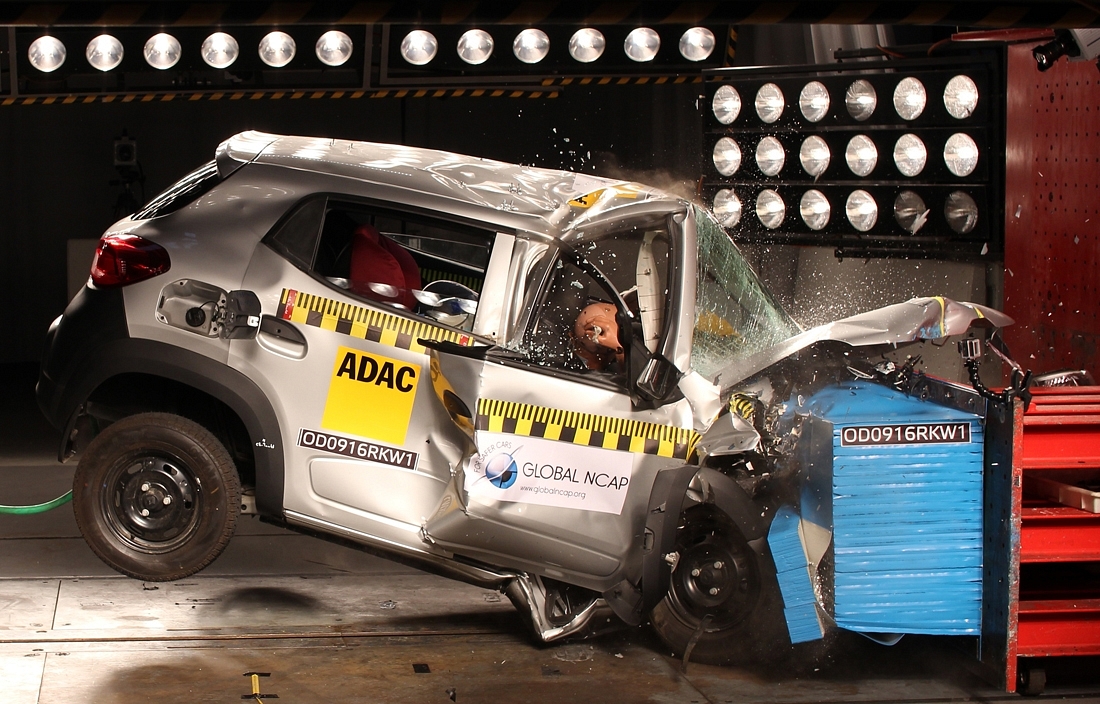Ideas
It’s OK If Indian Cars Don’t Meet International Safety Standards
- Installing more features will inevitably make cars more expensive for buyers.
- If cars become more costly than they are now, those who can’t afford it at the high price will be stuck with their motorcycles.

Renault Kwid during testing by Global NCAP / Picture from Global NCAP
The Global New Car Assessment Programme( Global NCAP) recently tested five Indian cars :
- Renault Kwid
- Maruti Suzuki Celerio
- Maruti Suzuki Eeco
- Mahindra Scorpio
- Hyundai Eon
All of them were rated zero in Adult Occupant Protection. This news was followed by a flurry of opinion-editorials from prominent newspapers (here, here and here) accusing car manufacturers of ignoring safety concerns, the government of being guilty in not putting place proper regulation. Here is the real story. David Ward, Secretary General of Global NCAP said this in the Indian Automobile Safety Conference hosted by IRTE in Faridabad -
‘Global NCAP also welcomes the forthcoming launch of a Bharat New Car Assessment Programme which can help build a market for safer cars in India.’
So much for the outrage about the government not doing anything. Unfortunately the government is doing something.The ‘government doing nothing’ part of most op-eds was the adding of ghee to the fire of public outrage over the issue.
A lot of concerned (and most probably wealthy) netizens outraged over how these automakers followed lax standards in India while the cars they manufacture in India for export to developing countries conform to international safety standards. Some said the automakers did not value Indian lives the same way they did the lives of people in the west.
Now to address the part about lax safety standards among Indian automakers. I am extremely glad that Indian automakers are yet to adopt stricter safety standards. They are saving lots of lives by their heroic action of resisting such pressures from uninformed members of the civil society. Rahul Bajaj was absolutely right in comparing Global NCAP to Marie Antoinette when he remarked:
You may be aghast reading the above but I hope to have convinced you by the time you finish reading the article.
Any safety standard will not come without it’s own cost. Take for example an airbag. Installing it would make the car costly by atleast 35,000 INR in India. The cost of the cheapest variant of Renault Kwid (Ex- showroom Delhi) is 2,56, 000 INR.
Making Airbags compulsory will lead to an increase in prices of at least 10 percent. If you hadn’t noticed already, the cost of installing an airbag is greater than the cost of a few low end Motorcycle Variants. When this regulation comes into effect, fewer people will buy cars than a scenario where no such regulation is in effect. This is bad news for India. How?
Indians are slowly shifting from motorcycles to cars. We buy cars as soon as we can afford it. Some of us may refrain from buying it for various reasons, but most do buy them as soon as they can afford it. If cars become more costly than they are now, those who can’t afford it at the high price will be stuck with their motorcycles.
Economist Alex Tabarrok points out in his blog that motorcycles are more dangerous than cars in the US by quoting a Department of Transportation report on the same. According to the report, the number of deaths in motorcycles were 26 times more than cars per mile travelled. He also points out that similar ratios are observed in the UK and Australia. No such data on India exists (I would be glad to know if it does).
If this is the case in the developed world, India will most probably be worse. Here, we frequently get to witness groups of three and sometimes entire families (including kids) riding on motorcycles. A WHO report estimates that the death percentage of two or three wheelers at 33.9 percent while those of four wheelers at 17.2 percent in India.
While this doesn’t tell you per mile statistics, it does give a hint at how those statistics might be. The Global NCAP rates all those five cars zero in Adult Occupant Protection. I wonder what the rating of motorcycles would be ( -5 ?) .
Not convinced yet? Think about what the regulation would do when it is implemented. The ratio of unsafe motorcycles to relatively safe cars will increase. Won’t it cause more accidents? Also, seat-belts are way more effective than airbags.
If the government and those concerned netizens are so worried about road safety, wouldn’t it be prudent and cheaper to first enforce seat-belts regulations which are already on the books?
Why is there a pressing need to make cars costly to low income buyers? ‘Unsafe’ Cars as Alex points out can save lives. Don’t demand regulations which will make them unaffordable to satisfy the need to outrage.
Support Swarajya's 50 Ground Reports Project & Sponsor A Story
Every general election Swarajya does a 50 ground reports project.
Aimed only at serious readers and those who appreciate the nuances of political undercurrents, the project provides a sense of India's electoral landscape. As you know, these reports are produced after considerable investment of travel, time and effort on the ground.
This time too we've kicked off the project in style and have covered over 30 constituencies already. If you're someone who appreciates such work and have enjoyed our coverage please consider sponsoring a ground report for just Rs 2999 to Rs 19,999 - it goes a long way in helping us produce more quality reportage.
You can also back this project by becoming a subscriber for as little as Rs 999 - so do click on this links and choose a plan that suits you and back us.
Click below to contribute.
Latest